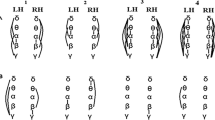Abstract
We investigated the interaction of β-rhythm parameters with α and θ rhythms in a paradigm of cognitive set as a response on facial expression in 35 healthy adults. Data were analyzed by means of continuous wavelet transform on the basis of “maternal” complex Morlet-wavelet in a range of 1–35 Hz. Distribution cards of the values of the wavelet-transform coefficient (WLC) module characterizing potentials amplitude were analyzed. We used indicators of the mean and maximal WLC levels. A significant interaction between β2 and α rhythms at the mean WLC level at the stage of set formation was revealed in a group with rigid set, and a correlation coefficient was 0.57. The interaction between β2 and θ rhythms at the mean WLC level (correlation coefficient was 0.74) and WLC maximum (correlation coefficient was 0.8) at the same experimental stage in the group with the flexible set was found.
Similar content being viewed by others
References
Kostandov, E.A. and Cheremushkin, E.A., Psychophysiological signs of high-flexible forms of set on the emotionally negative facial expression, Zh. Vyssh. Nervn. Deyat. im. I. P. Pavlova, 2013, vol. 63, no. 2, p.175.
Yakovenko, I.A., Cheremushkin, E.A., and Kozlov, M.K., Changes in the beta rhythm on acquisition of a set to an emotional facial expression with lengthening of the time interval between the warning and trigger stimuli, Neurosci. Behav. Physiol., 2014, vol. 44, no. 9, p. 1031.
Engel, A.K., Fries, P., and Singer, W., Dynamic predictions: Oscillations and synchrony in top-down processing, Nat. Rev. Neurosci., 2001, vol. 2, no. 10, p.704.
Engel, A.K. and Fries, P., Beta-band oscillations—signalling the status quo?, Curr. Opin. Neurobiol., 2010, vol. 20, no. 2, p.156.
Yakovenko, I.A., Kozlov, M.K., and Cheremushkin, E.A., Changes in the evoked beta rhythm in the cerebral cortical hemispheres on formation of a set to an emotional facial expression in conditions of loading on working memory, Zh. Vyssh. Nervn. Deyat. im. I.P. Pavlova, 2012, vol. 62, no. 3, p.302.
Bibbig, A., Middleton, S., Racca, C., et al., Beta rhythms (15–20 Hz) generated by nonreciprocal communication in hippocampus, J. Neurophysiol., 2007, vol. 97, no. 4, p. 2812.
Linás, R.R., Grace, A.A., and Yarom, Y., In vitro neurons in mammalian cortical layer 4 exhibit intrinsic oscillatory activity in the 10-to 50-Hz frequency range, Proc. Natl. Acad. Sci. U. S. A., 1991, vol. 88, no. 3, p.897.
Steriade, M., Grouping of brain rhythms in corticothalamic systems, Neuroscience, 2006, vol. 137, no. 4, p. 1087.
Uhlhaas, P.J., Haenschel, C., Nickolic, D., and Singer, W., The role of oscillations and synchrony in cortical networks and their putative relevance for the pathophysiology of schizophrenia, Schizophr. Bull., 2008, vol. 34, no. 5, p.927.
Sarnthein, J., Morel, A., and von Stein, Jeanmonod D., Thalamic theta fields potentials and EEG: High thalamocortical coherence in patients with neurogenic pain, epilepsy and movement disorders, Thalamus Relat. Syst., 2003, vol. 2, no. 3, p.231.
Rodríguez-Martínez, E.I., Barriga-Paulino, C.I., Rojas-Benjumea, M.A., and Gómez, C.M., Co-maturation of theta and low-beta rhythms during child development, Brain Topogr., 2015, vol. 28, no. 2, p.250.
de Munk, J.C., Goncalves, S.I., Mammoliti, R., et al., Interaction between different EEG frequency bands and their effect on alpha-fMRI correlation, NeuroImage, 2009, vol. 47, no. 1, p.69.
Roopun, A.K., Kramer, M.A., Carrasedo, L.M., et al., Temporal interaction between cortical rhythms, Front. Neuroisci., 2008, vol. 2, no. 2, p.145.
Nikulin, V.V., Nolte, G., and Curio, G., Cross-frequency decomposition: A novel technique for studying interactions between neuronal oscillation with different frequencies, Clin. Neurophysiol., 2012, vol. 123, no. 7, p. 1353.
Niculin, V.V. and Brismar, T., Phase synchronization between alpha and beta oscillation in the human electroencephalogram, Neuroscience, 2006, vol. 137, no. 2, p.647.
Schanze, T. and Eckhorn, R., Phase correlation among rhythms present at different frequencies: Spectral methods, application to microelectrode recordings from visual cortex and functional implications, Int. J. Psychophysiol., 1997, vol. 26, nos. 1-3, p.171.
Tass, P.A., Fieseler, T., Dammers, J., et al., Synchronization tomography: A method for three-dimensional localization of phase synchronized neuronal population in the human brain using magnetoencephalography, Phys. Rev. Lett., 2003, vol. 90, no. 8, p. 088101.
Uznadze, D.N., Experimental basics of set psychology, in Eksperimental’nye issledovaniya po psikhologii ustanovki (Experimental Studies on the Set Psychology), Tbilisi: Izd. Akad. Nauk GSSR, 1958, p.5.
Ekman, P. and Friesen, W.V., Pictures of Facial Affect, Palo Alto, Calif.: Consult Psychol. Press, 1976.
Chik, D., Theta-alpha cross-frequency synchronization facilitates working memory control—A modeling study, Springer Plus, 2013, vol. 2, no. 14, p.1.
van der Meij, R., Kahana, M., and Maris, E., Phaseamplitude coupling in human electroencephalography is spatially distributed and phase diverse, J. Neurosci., 2012, vol. 32, no. 1, p.111.
Roux, F. and Uhlhaas, P.J., Working memory and neural oscillations: Alpha-gamma versus theta-gamma codes for distinct WM information?, Trends Cognit. Sci., 2014, vol. 18, no. 1, p.16.
Astasheva, E.V., Investigation of oscillatory activity and interrelations of structures in the limbic system of the brain, Fundam. Issled., Biol. Nauki, 2011, no. 12, part 4, p.699.
Fries, P., A mechanism for cognitive dynamics: Neuronal communication through neuronal coherence, Trends Cognit. Neurosci., 2005, vol. 9, no. 10, p. 474.
Author information
Authors and Affiliations
Corresponding author
Additional information
Original Russian Text © I.A. Yakovenko, E.A. Cheremushkin, M.K. Kozlov, 2017, published in Fiziologiya Cheloveka, 2017, Vol. 43, No. 6, pp. 37–44.
Rights and permissions
About this article
Cite this article
Yakovenko, I.A., Cheremushkin, E.A. & Kozlov, M.K. Coupling of the β Rhythm and Slow Electric Activity of the Cerebral Cortex during the Performance of Go/NoGo Tasks and the Identification of the Facial Expression. Hum Physiol 43, 637–643 (2017). https://doi.org/10.1134/S0362119717050164
Received:
Published:
Issue Date:
DOI: https://doi.org/10.1134/S0362119717050164



